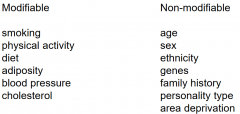![]()
![]()
![]()
Use LEFT and RIGHT arrow keys to navigate between flashcards;
Use UP and DOWN arrow keys to flip the card;
H to show hint;
A reads text to speech;
10 Cards in this Set
- Front
- Back
|
Give 6 modifiable and non-modifiable risk factors of CVD |

|
|
|
State 5 ways in which risk is measured |
•Absolute risk •Relative risk (RR) •Odds ratio (OR) •Attributable risk (AR) •Population attributable risk (PAR) |
|
|
What is absolute risk? How do you calculate it? |
number of new cases in a given population over specified time for those at risk those with an exposure/risk factor e.g. number of people with HF/number of people who are obese |
|
|
What is relative risk? How do you calculate it? |
- comparing those who have exposure/risk factor to those who don't e.g. CVD in obese and non-obese people - calculated by determining the absolute risk in each group and then comparing: exposed/non-exposed |
|
|
How do you interpret relative risk? |

|
|
|
In what type of studies would you use relative risk and odds ratios, respectively? |
•RR can only be obtained from cohort studies •OR used for case-control and cross-sectional studies |
|
|
What is attributable risk? |
total incidence minus background risk i.e. "incidence due to exposure" |
|
|
How do you calculate AR%? |
AR%= 100/incidence of disease in exposed |
|
|
How do calculate population attributable risk? |
PAR=AR-prevalence of exposure |
|
|
give an example of; single risk factor strategy population health strategy high baseline risk strategy |
single risk factor strategy: treat bp in all individuals with high bp population health strategy: lower bp in whole population high baseline risk strategy:treat bp and other risk factors in individuals with high overall risk |

